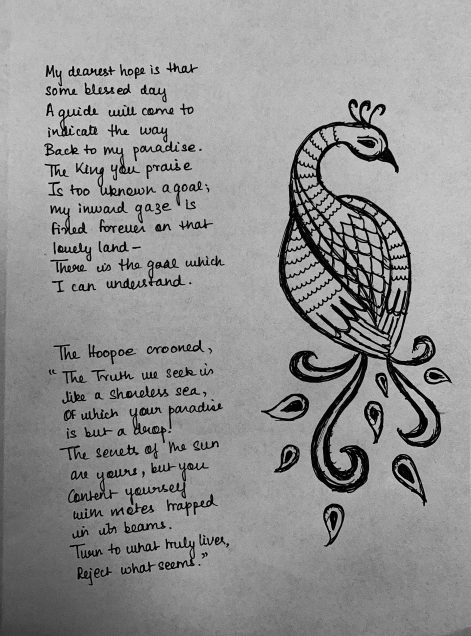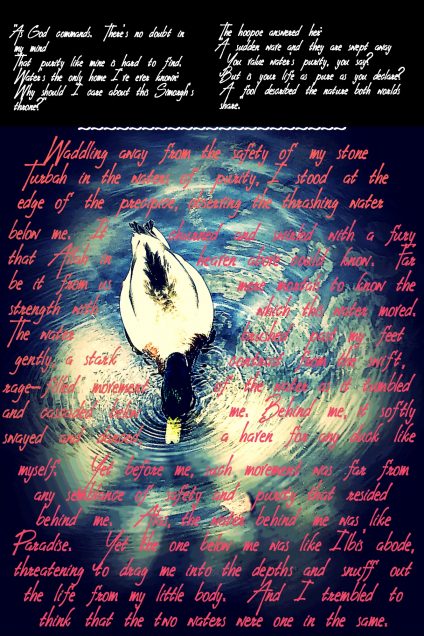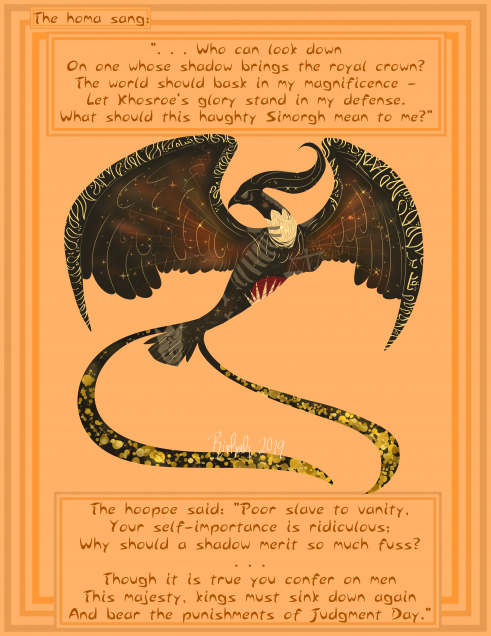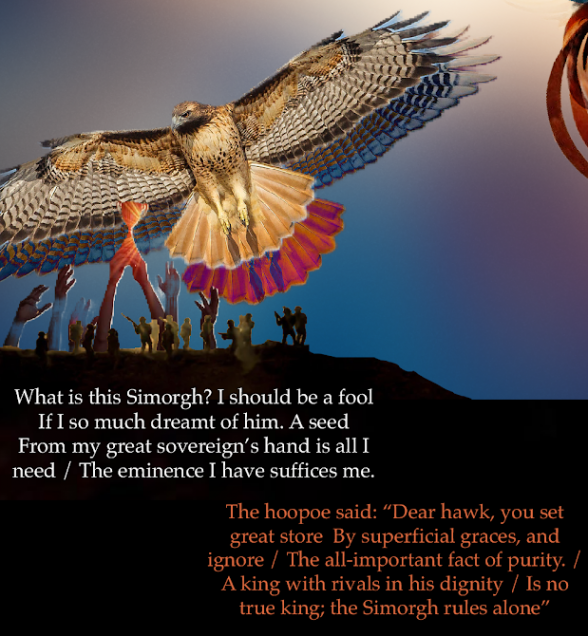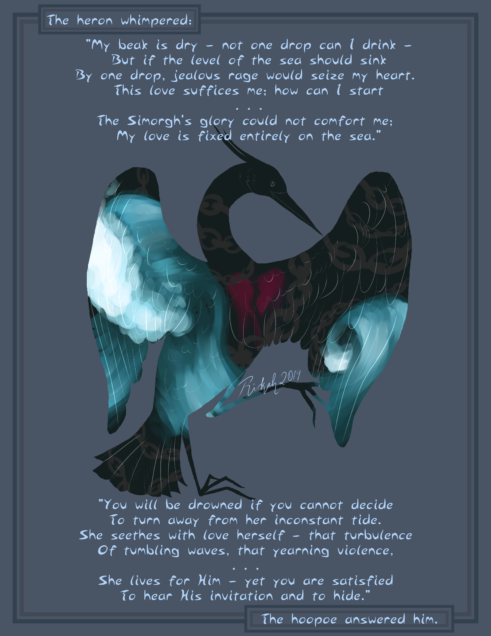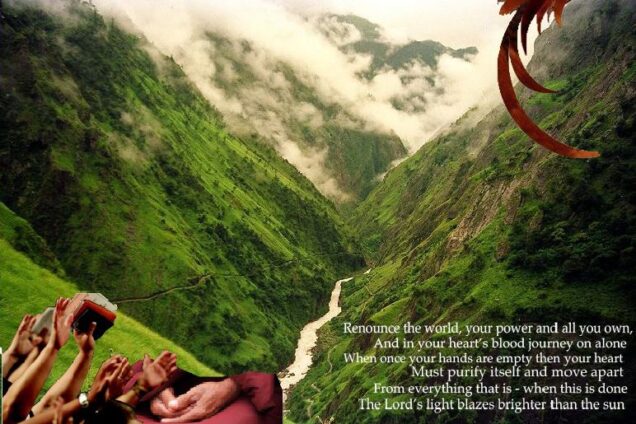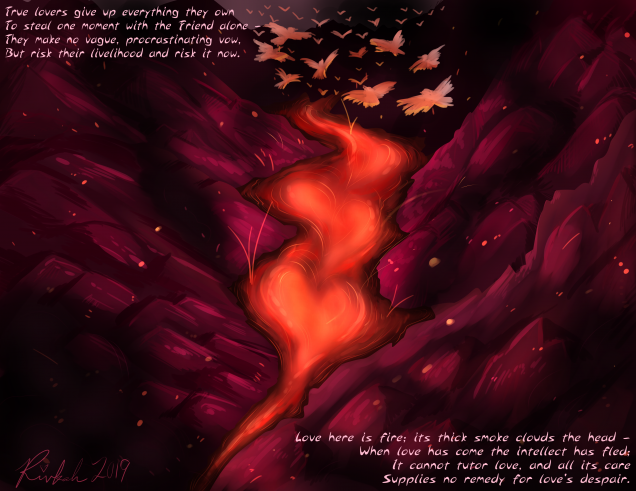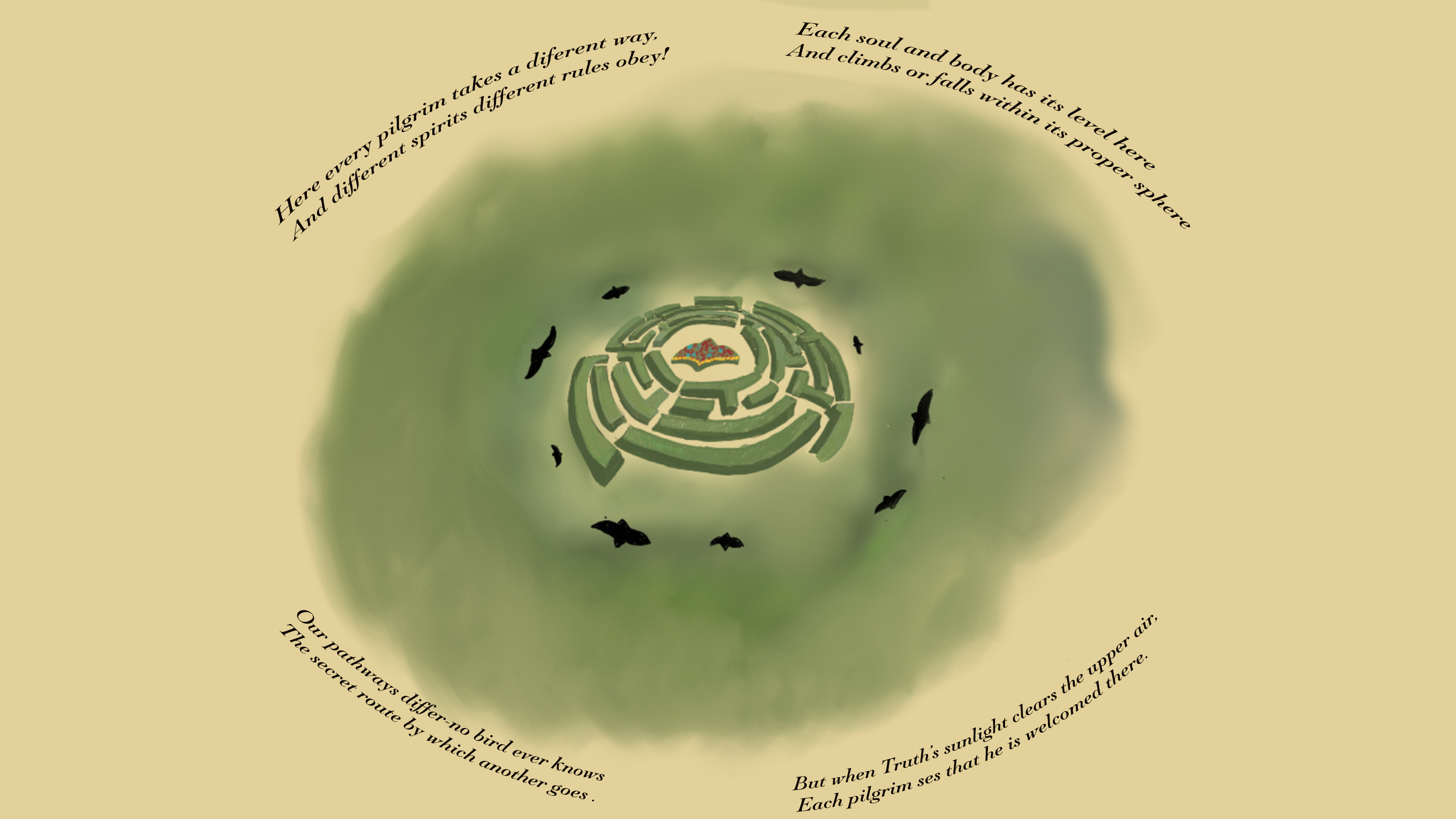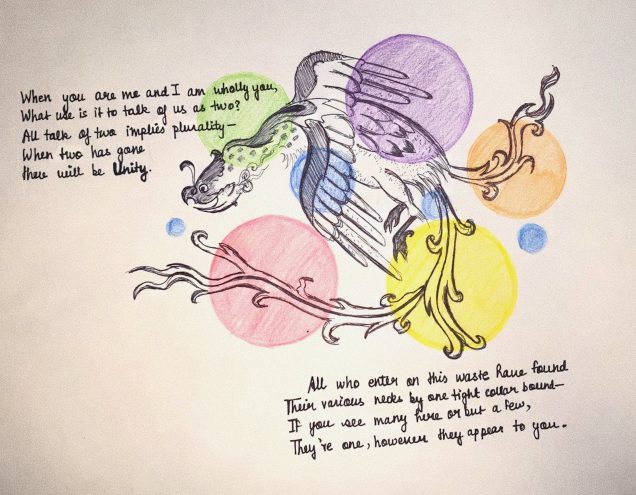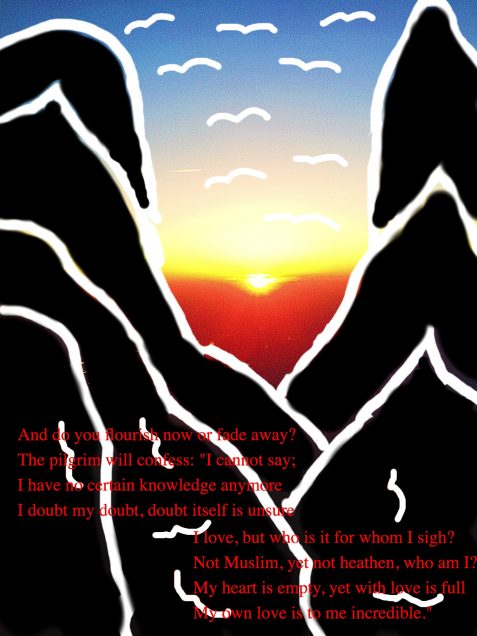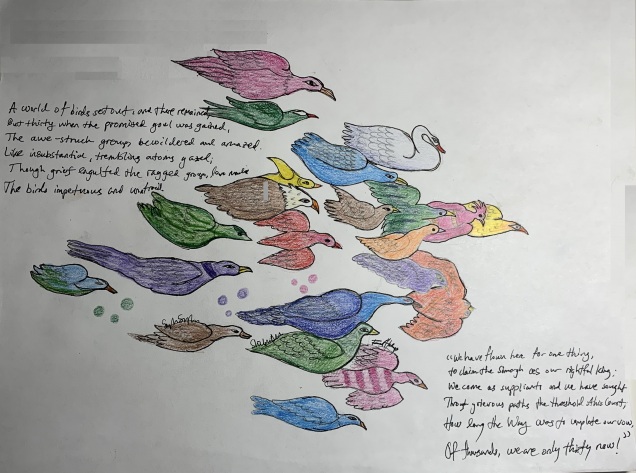The Conference of the Birds
The Hoopoe Tells the Birds About Their King, the Simorgh
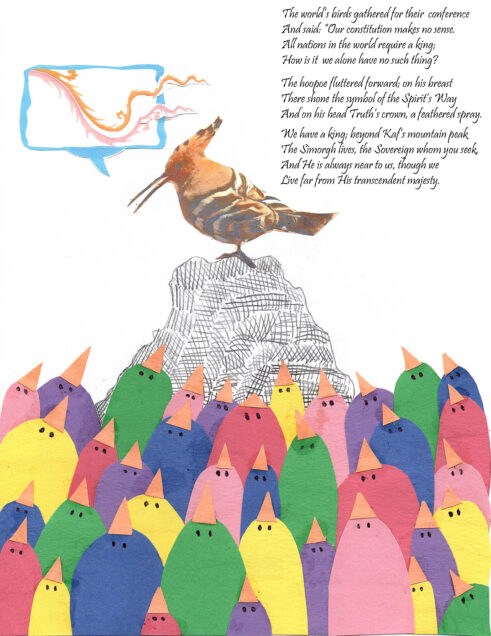 This image is a collage style rendition of the Hoopoe’s announcement of the journey to the Simorgh to the conference of birds. Each visual aspect of the piece has a unique source; the hoopoe is a real picture of the bird, the word cloud comes from Photoshop, the Simorgh’s tail was created in a digital art program, the hill upon which the hoopoe sits was sketched in pencil, the birds gazing up at the hoopoe were made using construction paper and their eyes were drawn in pen. I compiled these many mediums to foreshadow the numerous art styles that would be used to portray the birds and valleys in the slides to come. Everyone’s path to the divine is unique, and thus every rendition of the journey must itself be unique. The Simorgh’s tail extends past the word bubble to show his all-encompassing power and to hint that he is closer to the birds than they might think. The background of the image is purposefully left blank in order to illustrate how each bird will forge their own path to God. The sky will be their canvas and, since the journey has yet to begin, it is a blank one.
This image is a collage style rendition of the Hoopoe’s announcement of the journey to the Simorgh to the conference of birds. Each visual aspect of the piece has a unique source; the hoopoe is a real picture of the bird, the word cloud comes from Photoshop, the Simorgh’s tail was created in a digital art program, the hill upon which the hoopoe sits was sketched in pencil, the birds gazing up at the hoopoe were made using construction paper and their eyes were drawn in pen. I compiled these many mediums to foreshadow the numerous art styles that would be used to portray the birds and valleys in the slides to come. Everyone’s path to the divine is unique, and thus every rendition of the journey must itself be unique. The Simorgh’s tail extends past the word bubble to show his all-encompassing power and to hint that he is closer to the birds than they might think. The background of the image is purposefully left blank in order to illustrate how each bird will forge their own path to God. The sky will be their canvas and, since the journey has yet to begin, it is a blank one.
Background music: composition for Tar
downloaded from freesound.org
The Nightingale
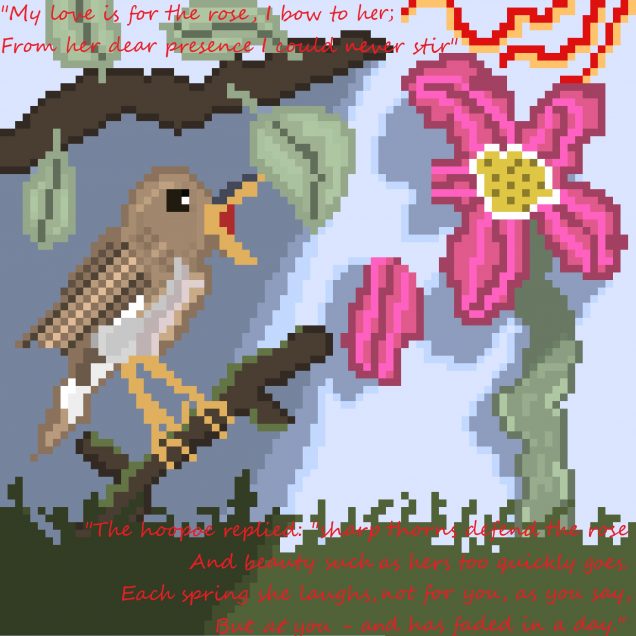 This is an image of the nightingale who is too in love with the rose to go on the journey. I chose to depict the nightingale at rest, as he has no desire to leave the rose’s side. While he stares transfixed at his love, he fails to notice some important details of the world around him, such as the petal falling off the flower or the Simorgh’s tail feathers in the top right corner of the scene. The petal is meant to symbolize the brevity of life, and the nightingale’s failure to acknowledge his love’s short life makes him far less likely to ever want to seek out eternal greatness in the Simorgh. The Simorgh is actually the light source for the shot, and the bird’s positioning underneath the branch is meant to symbolize his ignorance of God. The flower is turned to the Simorgh and away from the bird, showing that even the most basic forms of life are capable of acknowledging the Simorgh’s authority as the one above all. I made this picture using grid-paint.com, a free pixel art creation studio.
This is an image of the nightingale who is too in love with the rose to go on the journey. I chose to depict the nightingale at rest, as he has no desire to leave the rose’s side. While he stares transfixed at his love, he fails to notice some important details of the world around him, such as the petal falling off the flower or the Simorgh’s tail feathers in the top right corner of the scene. The petal is meant to symbolize the brevity of life, and the nightingale’s failure to acknowledge his love’s short life makes him far less likely to ever want to seek out eternal greatness in the Simorgh. The Simorgh is actually the light source for the shot, and the bird’s positioning underneath the branch is meant to symbolize his ignorance of God. The flower is turned to the Simorgh and away from the bird, showing that even the most basic forms of life are capable of acknowledging the Simorgh’s authority as the one above all. I made this picture using grid-paint.com, a free pixel art creation studio.
Background music: Original composition for Santur
by Danial Shariat
The Parrot
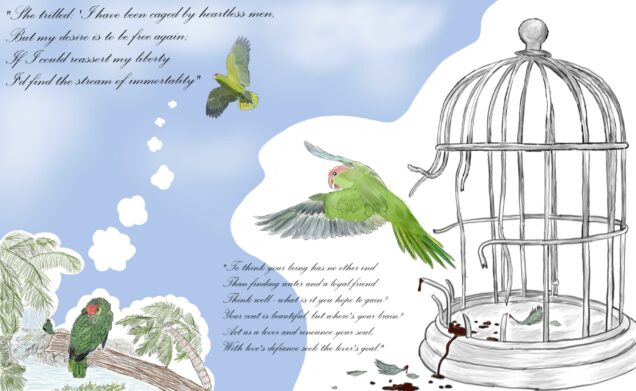 This is an image of the parrot who is too proud of its spirituality. In my drawing, using an app on my laptop called Autodesk Sketchbook, I drew a parrot breaking free of her cage and flying through the sky, finally free and dreaming of a land in which she could be free eternally. On the cage, there are fallen feathers, some with blood on them, to depict the struggle the parrot had to escape. There is also blood dripping from the end of the cage to a puddle on the floor to emphasize the pain she has dealt with. While in the sky, flying free for the first time, the parrot dreams of a land she's never seen, but has imagined enough for it to be a clear photo in her head. In her dream, she sits on the branch of a tropical tree, resting comfortably and listening to the sounds of the waterfall stream in front of her. The stream of immortality. Here she stays with its guardian, Khezr, who she thinks treats her as an equal and not as a prisoner. Her dream world is noticeably more stylistically sketched, the colors of the waterfall less visible and the colors of her feather a different shade. This is to symbolize that her dream is not reality. That what she's imagining isn't real and will never be. She doesn't truly know what the stream or Khezr looks like, so it's coloring isn't as sure as the rest of the image. The bird in her dream also looks relatively different because she will never BE the bird in that dream. It's unrealistic, not set in stone, and the drawing mimics this.
This is an image of the parrot who is too proud of its spirituality. In my drawing, using an app on my laptop called Autodesk Sketchbook, I drew a parrot breaking free of her cage and flying through the sky, finally free and dreaming of a land in which she could be free eternally. On the cage, there are fallen feathers, some with blood on them, to depict the struggle the parrot had to escape. There is also blood dripping from the end of the cage to a puddle on the floor to emphasize the pain she has dealt with. While in the sky, flying free for the first time, the parrot dreams of a land she's never seen, but has imagined enough for it to be a clear photo in her head. In her dream, she sits on the branch of a tropical tree, resting comfortably and listening to the sounds of the waterfall stream in front of her. The stream of immortality. Here she stays with its guardian, Khezr, who she thinks treats her as an equal and not as a prisoner. Her dream world is noticeably more stylistically sketched, the colors of the waterfall less visible and the colors of her feather a different shade. This is to symbolize that her dream is not reality. That what she's imagining isn't real and will never be. She doesn't truly know what the stream or Khezr looks like, so it's coloring isn't as sure as the rest of the image. The bird in her dream also looks relatively different because she will never BE the bird in that dream. It's unrealistic, not set in stone, and the drawing mimics this.
Background Music: Original Composition for Santur
by Danial Shariat
The Peacock
This scene is that of the peacock whose main claim to fame is his beauty. He claims that he was made by the painter of the world and his pride lies with his external beauty. The peacock wishes to return to paradise from where he was banished. When he tells the Simorgh the reason for his not wanting to participate in the spiritual journey to find the Simorgh, the Hoopoe reminds him how insignificant his wish is compared to their ultimate goal, how the peacock is enamoured by “evanescent dew” when the ocean could be his.
Therefore, I decided to draw the peacock in the basest of the colours- black and white, with a simple pen, so as to downplay his splendid beauty that makes him so vain. Which leads us to the question, what is more important- the body or the soul? The peacock’s conceit is a lesson for us, to rise above superficial matters and transcend to the ultimate goal, which is the divine.
Background Music: Original Composition for Santur
by Danial Shariat
The Partridge
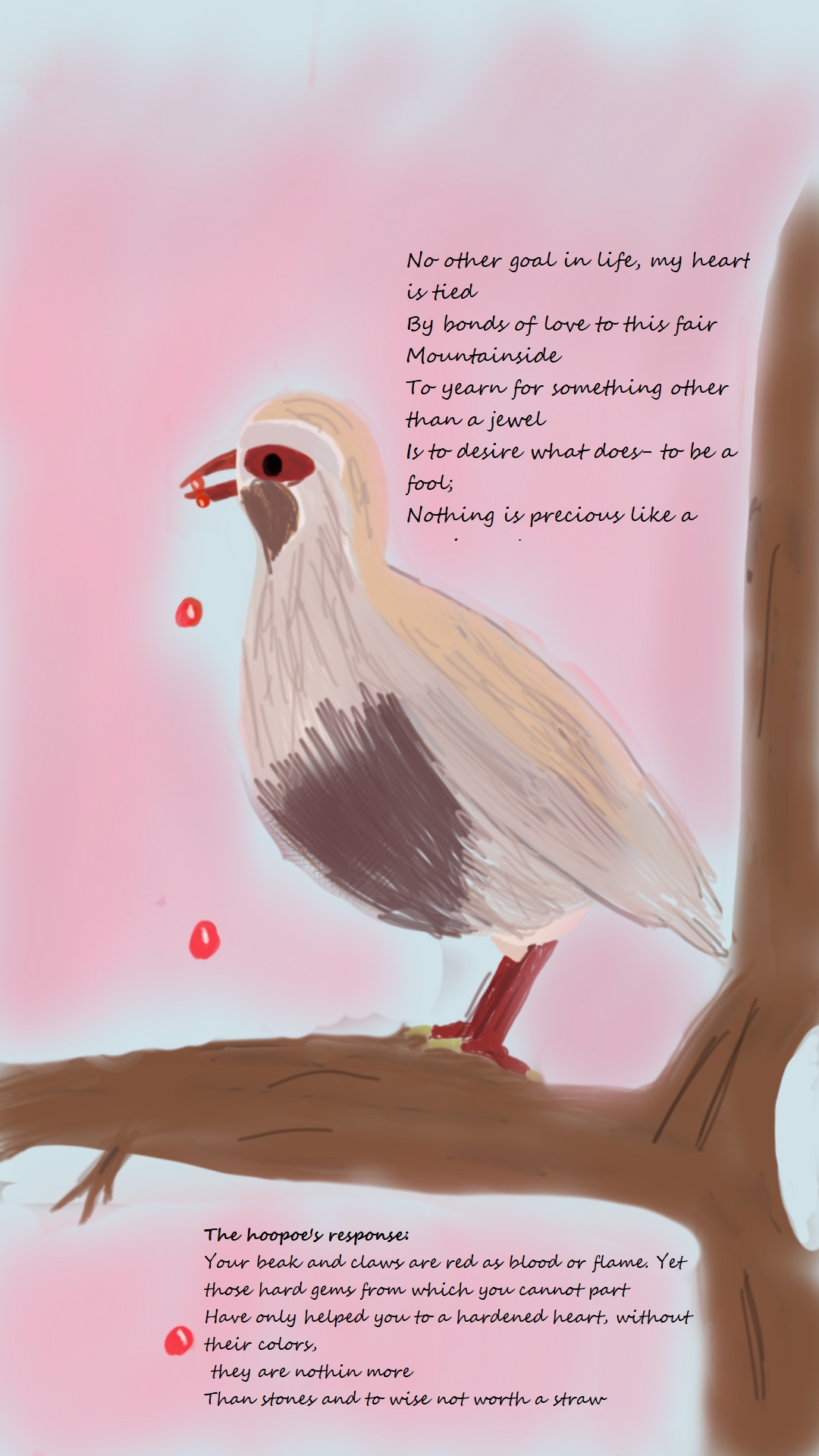 This is an image of the partridge, which is too attached to earthly treasures and is almost childlike. He is so desperate for shiny objects that have superficial material worth instead of looking for the eternal which embodies spiritual wealth. The partridge's attachment to the jewels and their worth have shut him off from experiencing anything including even flying. I drew the partridge standing on the edge of a tree, so close to experiencing the freedom of flight but still attached to his worldly possessions. He is holding the jewels in his beak but slowly, one by one they are falling away to the world below. I used an app called SketchUp 3d on my tablet to draw this drawing. It allowed me to draw freehand while using the computer.
This is an image of the partridge, which is too attached to earthly treasures and is almost childlike. He is so desperate for shiny objects that have superficial material worth instead of looking for the eternal which embodies spiritual wealth. The partridge's attachment to the jewels and their worth have shut him off from experiencing anything including even flying. I drew the partridge standing on the edge of a tree, so close to experiencing the freedom of flight but still attached to his worldly possessions. He is holding the jewels in his beak but slowly, one by one they are falling away to the world below. I used an app called SketchUp 3d on my tablet to draw this drawing. It allowed me to draw freehand while using the computer.
Background music: Original composition for Santur
by Danial Shariat
The Duck
This is an image of a duck who is too proud of her purity because she is always performing ablations in water. I chose to represent the duck in the way I did for a number of reasons. First of all, it is not an artistic rendering, but rather a photograph of a duck I took while at the Boston Common. I do not have much artistic ability myself, so I figured the best way to represent the bird I was given would be through a photographic medium. I was, however, able to edit the photograph of the duck through the free Pixlr photo editor software online. Not only did I edit the shading and coloring of the photo through the software, but I also included a prose text that I wrote myself. I felt as though the mere photograph did not do much justice for the tale of the Duck in Conference of the Birds, so I decided to add a prose piece alongside it chronicling the experience of coming to the realization of the folly of only trusting the water for life’s salvation. The duck in this photograph submerges its beak in the water, and will only remain with water's false promises. A stone lies off to her side, representing a stone turbah of Islam, a prayer stone. The duck presents herself as pious and pure, with her prayer rituals and purity of always washing herself in the water. Yet, just like the duck in the photograph, she will not look above to see the real promise of God right beyond the water, but rather bury her head into her superficial purity.
The background music is an original composition for Santur by Danial Shariat.
The Homa
This piece depicts the homa, who is too proud of its status as a mythical bird. Its silhouette encases warm, bright colors to invoke his associations with royalty and auspiciousness. I placed references to these themes all over the bird: his tail feathers display speckling analogous to gold coins, his wings have burnt orange patterning like rays of the sun to indicate his high opinion of himself, and royal crowns accent his torso. These decorations have various blurring and fracturing effects to indicate their ephemeral materialism. The homa lacks legs in order to match the legends that describe him as unable to land. The scattered bones and the crown-bearing skull symbolize the hoopoe’s critique, where even the power of kings is fleeting and irrelevant in the face of the Simorgh.
I digitally painted this piece using the art program Clip Studio Paint.
Background music: Original composition for Santur
by Danial Shariat
The Hawk
This is a scene of the Hawk who is too proud of its social standing as the bird of kings.
I chose to depict the Hawk with its wings fully extended, glorious and majestic... and fully aware of it. Although the tail of the Simorgh is visible in the corner, with its red tail feathers beckoning from outside the frame, the Hawk is turned away from the Simorgh's call. The Hawk chooses to fixate upon worldly glories, namely victory on the battlefield and the favor of kings. However, I also chose to have a faded, yet colored, Hawk superimposed behind the physical Hawk. This is meant to represent the larger potential for divinity within the Hawk, if only it turned towards the Simorgh's call. The presence of the Simorgh in the corner (although only partly due to the fact that the Hawk has yet to embrace the call of divinity) represents that the potential for connection with the Simorgh is not fully lost. This scene was created by blending photographs on Adobe Photoshop Mix.
Background music: Original composition for Santur by Danial Shariat.
The Heron
The heron is too enamored by the ocean to leave its side in order to pursue the Simorgh. The piece's simple design encapsulates his single-minded obsession with the sea. He describes his love in terms of “jealous rage” and haunting the shore in desolation. His attachment to the ocean engulfs him, and so the sea occupies the main position in his silhouette. Mirroring how the hoopoe criticized the heron for loving an “inconstant tide,” the waves designed within the heron are tumultuous and violent. From the painted darkness of the heron’s depicted misery is a bleeding, broken heart. I accented his form in numerous, subtle chains in order to demonstrate how enslaved he is to the Self and to a lawless body of water that cannot reciprocate his love.
This composition was digitally painted in Clip Studio Paint.
Background music: Original composition for Santur
by Danial Shariat
The Owl
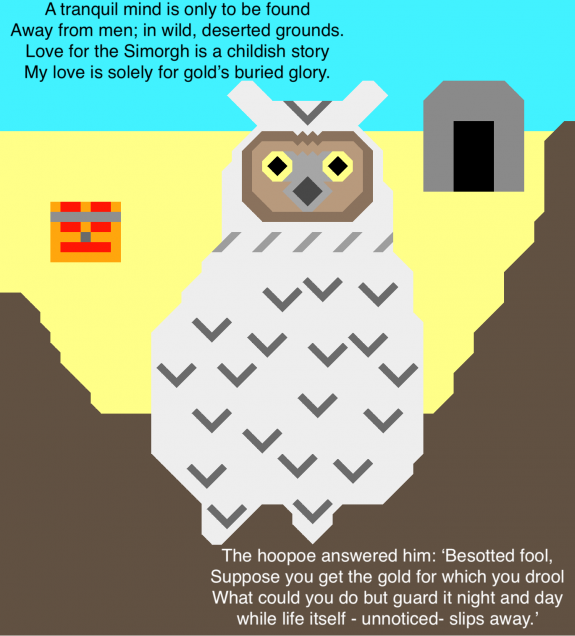 This is an image of the owl, who is too attached to hidden treasures. My goal for the owl was to distinguish the flaw of the owl within the image. Therefore, I chose to have the owl's back facing the audience and have the owl turn towards them. What lies beyond the owl is what he is guarding from others: buried treasure. As such, even as he is making the excuse of why he doesn’t want to go on the journey, the owl is clearly unable to do anything at all, but constantly guard the material riches that he has found. I also included the ruins in the background, as to depict another line that the owl did say about the fact that ruins harbor buried treasure. I chose the color of the owl to be in shades of gray, as that made the process of making the owl simpler as well as having colors that give off some similarity to how the ruins are colored. Blue, yellow, and brown are meant to represent the sky, the deserted lands, and the branch that the owl sits to guard his findings from others. I made this image using grid-paint.
This is an image of the owl, who is too attached to hidden treasures. My goal for the owl was to distinguish the flaw of the owl within the image. Therefore, I chose to have the owl's back facing the audience and have the owl turn towards them. What lies beyond the owl is what he is guarding from others: buried treasure. As such, even as he is making the excuse of why he doesn’t want to go on the journey, the owl is clearly unable to do anything at all, but constantly guard the material riches that he has found. I also included the ruins in the background, as to depict another line that the owl did say about the fact that ruins harbor buried treasure. I chose the color of the owl to be in shades of gray, as that made the process of making the owl simpler as well as having colors that give off some similarity to how the ruins are colored. Blue, yellow, and brown are meant to represent the sky, the deserted lands, and the branch that the owl sits to guard his findings from others. I made this image using grid-paint.
Background Music: Original Composition for Santur
by Danial Shariat
The Finch
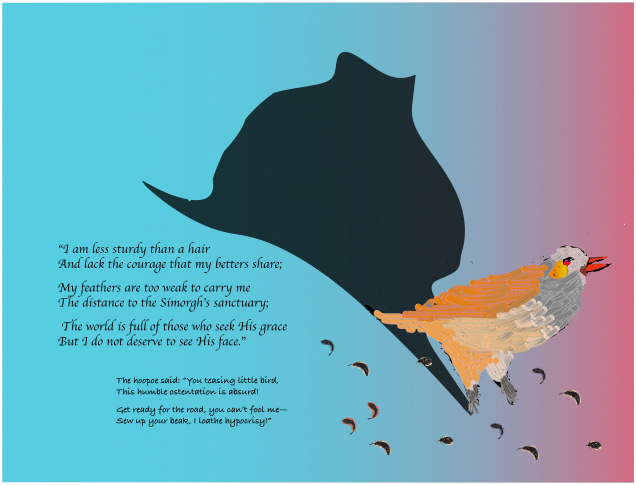 This is an image of the finch who claims to be too frail to go on the journey. My illustrated design of the finch presenting its excuse was created on Adobe Illustrator using a mixture of digitized drawings and vector graphics from the public domain. It reflects several key elements of the vanity of this particular bird. Firstly, the bird’s excuse rests on the idea that it is supposedly too weak to fly, “less sturdy than a hair” and “lacks ... courage”. In order to highlight the vanity of that excuse, the finch is puffy and clearly in healthy shape—very capable of flying. This element creates tension with the feathers we see falling from it, which highlight its own perception that it is too weak to make the journey to the Simorgh. The background also transitions from redder on the right to bluer on the left, indicating that while the bird perceives a danger which creates a shadow of herself, that shadow is in fact large and is enveloped in a calm blue, rather like a clear spring day. In other words, the danger she must overcome is really an internal vanity, whereas the finch is very able to take on that challenge. A final touch I added was the open beak, which is a reference to the hoopoe’s line, “Sew up your beak, I loathe hypocrisy!” I tried to portray both the shortcomings in the earthly finch as well as her potential for divinity and purification when she finally takes ownership of her strengths and begins the journey to God.
This is an image of the finch who claims to be too frail to go on the journey. My illustrated design of the finch presenting its excuse was created on Adobe Illustrator using a mixture of digitized drawings and vector graphics from the public domain. It reflects several key elements of the vanity of this particular bird. Firstly, the bird’s excuse rests on the idea that it is supposedly too weak to fly, “less sturdy than a hair” and “lacks ... courage”. In order to highlight the vanity of that excuse, the finch is puffy and clearly in healthy shape—very capable of flying. This element creates tension with the feathers we see falling from it, which highlight its own perception that it is too weak to make the journey to the Simorgh. The background also transitions from redder on the right to bluer on the left, indicating that while the bird perceives a danger which creates a shadow of herself, that shadow is in fact large and is enveloped in a calm blue, rather like a clear spring day. In other words, the danger she must overcome is really an internal vanity, whereas the finch is very able to take on that challenge. A final touch I added was the open beak, which is a reference to the hoopoe’s line, “Sew up your beak, I loathe hypocrisy!” I tried to portray both the shortcomings in the earthly finch as well as her potential for divinity and purification when she finally takes ownership of her strengths and begins the journey to God.
Background music: Original composition for Santur by Danial Shariat.
The Hoopoe Tells The Birds Of The Seven Valleys
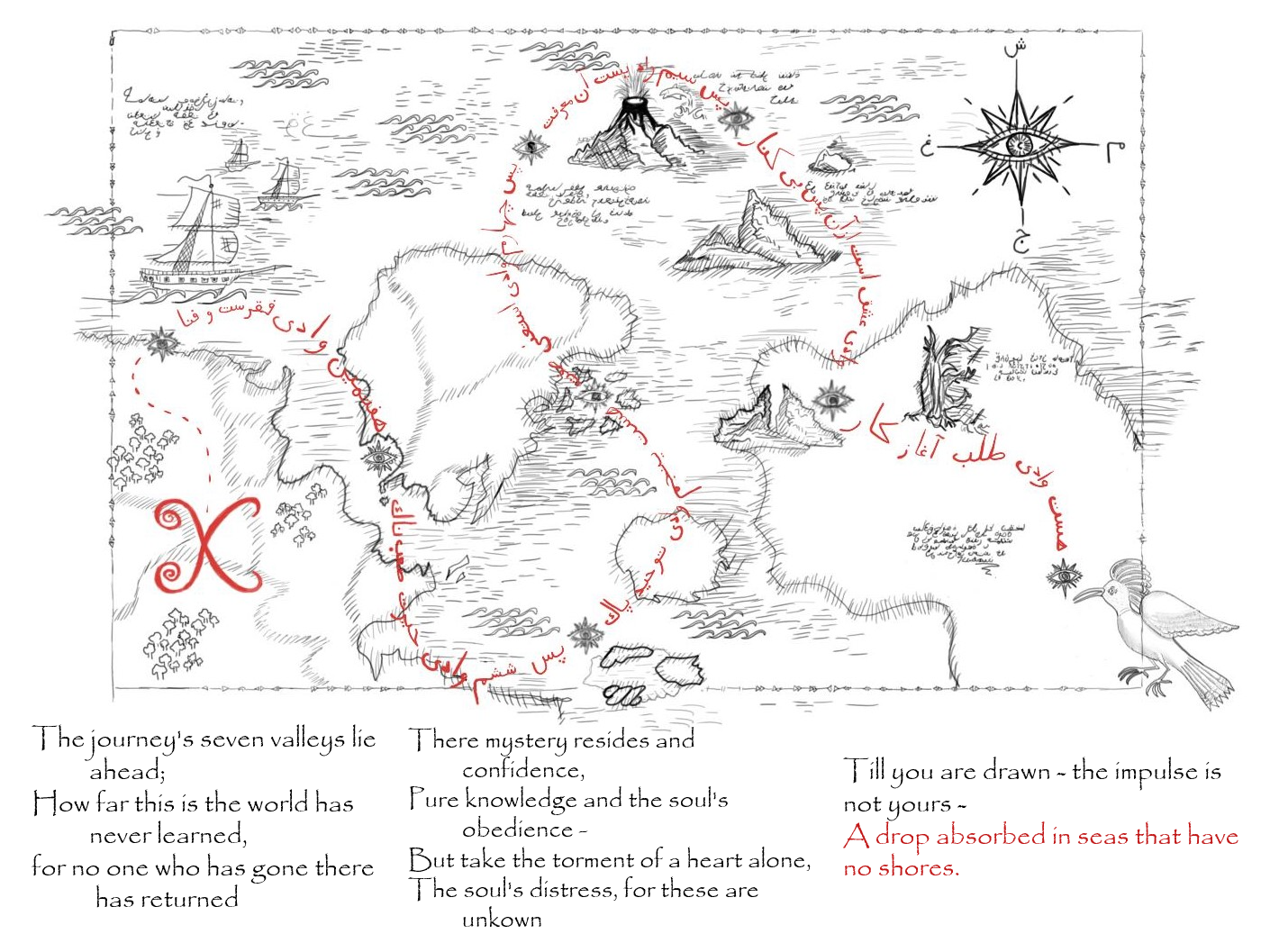
I drew the Hoopoe describing the journey as a treasure map because I believe the birds are on a journey to find their own treasure of sorts: the Simorgh. I incorporated the original Persian text that leads to each valley in order to try and create authenticity of my drawing. I also marked each point where the valleys are by an eye, because each valley requires insight, reflection, and self examination. I also tried to include things related to the valleys next to their valley points. For example, the valley of quest is drawn to mimic the actual artwork used for it in this website; the valley of love is depicted as a volcano to showcase the fiery journey that it entails; the valley of insight into mystery is is showcased by a question mark within the eye; the valley of detachment is made up of dispersed land pieces; for the valley of unity, I drew landforms and water marks that resemble a handshake; for the valley of bewilderment, I drew the eye within an alcove that resembles a question mark; and for the valley of poverty and nothingness, I drew nothing. The drawing of the Hoopoe is heavily inspired by the Hoopoe illustrated in Peter Sis’ edition of The Conference of The Birds.
I drew this on a drawing app called SketchBook.
Background music:
composition for Tar downloaded from freesound.org.
The Valley of the Quest
The Valley of the Quest requires the renunciation of the body's appetites. All previously held dogmas and beliefs must be abandoned, along with material possessions and superficial positions of power. I chose to depict hands clasped in prayer as well as a group of hands revering a speaker in a communal sermon at the bottom of the image. These images represent institutionalized religion, something the birds must now abandon in order to enter the Valley of the Quest and begin the spiritual journey. While this uphill journey will be challenging, it is illuminated by the Simorgh's light and the call to enlightenment. For this reason, I included the tail of the Simorgh beckoning from the heights of the Valley, where there is also more light and clouds in the image, representative of enlightenment and the mysterious unknown, respectively. This graphic was created by blending images on Adobe Photoshop Mix.
Background music: Original composition for Santur and Daf by Danial Shariat.
A note on the music, "I wanted this to imitate the sense of adventure one would experience when starting a quest, therefore I used the faster and more upbeat tempo. The constant triplet rhythm of the Daf also helps create the image of the birds continually swooping up and down through the valleys" (DS).
The Valley of Love
The Valley of Love is associated with abandoning the intellect in order to pursue the difficult journey to the divine. As a result, its palette is amorous, with deep, warm pinks characterizing the jagged rocks of the mountains and active lava glowing in bright reds, oranges, and yellows. Sparks in those same colors make the air seem to crackle with the intensity of the heat below. Even the birds flying above are illuminated, their colors lost and instead reflecting the danger, mystery, and allure of the valley. I designed the valley to coincide with the text chosen for it. Smoke rises from the rocks, depicting how unclear the way is. The powerful landscape demonstrates the risk described in the poetry. Love here is more powerful than logical comprehension, and so even the lava takes its shape.
This art was digitally painted using the application Clip Studio Paint.
The Valley of Insight into Mystery
The Valley of Insight into Mystery focuses on the different paths that each bird must take. No pathway is the same for two birds, and that is where insight comes from. When one embraces the path instead of trying to follow another's path, they lead to their own personal insight. I chose the maze as the focal point because while each bird is approaching the same maze, they each have to take a different path to reach the Simorgh in the middle. I left the birds colorless to keep their identity muted before the introduction to the Sigmorgh. I used a combination of two programs to make this illustration. For most of the drawing process, I use a program called SketchUp 3D. This program allows me to draw freehand on my tablet for my drawings. For all the text and arch placement, I used Adobe Photoshop.
Background music: Original composition for Santur and Daf
by Danial Shariat
A note on the music:
"This segment is very withdrawn and simple (almost atempo at times) in the hopes of creating a more introspective experience that would hopefully personify the private experience that is insight into mystery. If I accomplished what I attempted, there is a beauty in the santur that is matched by a haunting feeling." (DS)
The Valley of Detachment
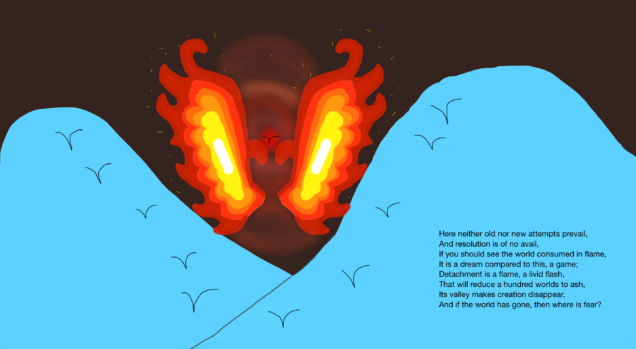 The scene depicts the Valley of Detachment, in which the pilgrim moves beyond the illusions of the self. The valley was first depicted in the poem as a frozen tempest, and as such I felt the valley should be a light blue color to represent the cold tundra. This valley shows how insignificant are the things we put emphasis on compared to the all-encompassing reality of the divine. The lines I took for the Valley of Detachment depict a lot about fire and how the world would burn to ash, so the central piece would be fire. I decided to depict the wings of the Simorgh as part of the fire since it not only signifies the anecdote about the moth and the flame, but it also gives a suggestion of how the pilgrims reach the Simorgh. They must go into the flames in order to burn away the physical self. This act would liberate the soul from the physical self, and the soul would be able to continue onwards to receive enlightenment without the weight of the self dragging it down. This composition is made with Sketchbook.
The scene depicts the Valley of Detachment, in which the pilgrim moves beyond the illusions of the self. The valley was first depicted in the poem as a frozen tempest, and as such I felt the valley should be a light blue color to represent the cold tundra. This valley shows how insignificant are the things we put emphasis on compared to the all-encompassing reality of the divine. The lines I took for the Valley of Detachment depict a lot about fire and how the world would burn to ash, so the central piece would be fire. I decided to depict the wings of the Simorgh as part of the fire since it not only signifies the anecdote about the moth and the flame, but it also gives a suggestion of how the pilgrims reach the Simorgh. They must go into the flames in order to burn away the physical self. This act would liberate the soul from the physical self, and the soul would be able to continue onwards to receive enlightenment without the weight of the self dragging it down. This composition is made with Sketchbook.
Background music: Original composition for Santur and Daf
by Danial Shariat
A note on the music:
"It was quite difficult to replicate detachment musically, therefore the closest I could come to was having many jumps from lower registers to much higher, replicating the ascending feeling of detachment." -- DS
The Valley of Unity
The Valley of Unity is where the individual loses his identity and realises that all things are one and are united within the divine. Here there is no plurality. Here a drop of rain merges with the ocean to attain its actual purpose to be one with the other droplets and lose itself in the sea which is an expression of ultimate reality.This Valley is described as celebrating the oneness of diversity, not the oneness locked in singularity. The soul is prompting all to be lost in Unity's inclusive span.
In my portrayal of The Valley of Unity, I decided to draw the Simorgh to represent the final goal of all the birds becoming one, losing their separate stories and identities as such. The Simorgh is in black and white and not colour to symbolise that it is the initial goal, not the actual Simorgh which the birds are striving towards. The different coloured circles symbolise the various birds losing themselves in their journeys, their pilgrimage to the Simorgh, in order to find themselves and therefore the the coloured circles are like droplets dissolving into one: "The lovely forms and colours are undone/And what seemed many things is only one".
Background music: Original composition for Santur and Daf
by Danial Shariat
A note on the music:
"This piece is entirely homophonic, as to represent unity.The constant octaves on the santur and the monotone drum help resemble the dichotomy of the multitudes that is contained in the soul as well as its unity with the divine." (DS)
The Valley of Bewilderment
The picture representing the Valley of Bewilderment is a mixture of artistic rendering and actual photography. The background picture is an actual picture of a sunset I took while on a flight to Virginia from Boston, and it has been colorized to an extent. The mountains and birds, however, are drawings that I added to the picture. All editing to the picture was completed through the photo editor Pixlr. As this picture represents a valley, there are mountains on either side forming a valley, and the Sun at the end represents the light of the Simorgh close by, only one valley away, the bright, bewildering light of this Simorgh. A number of birds glide safely through the valley to continue on their journey to their king, however this immense power and light of the Simorgh is too much for some of these birds to handle, and they plummet to their demise in the valley below. The verses of the poem that best represent the toils and the hope of this valley are also present. While the birds are undergoing much bewilderment of the senses, they are also experiencing much hope in the form of love, as stated in the verses.
The background music is an original composition for Santur and Daf by Danial Shariat.
A note on the music: "This is the most joyous piece, making use of a common Persian dance rhythm and syncopated melodies to create what is the most hectic and rhythmically complex of the pieces which would symbolize bewilderment" (DS).
The Valley of Poverty & Nothingness
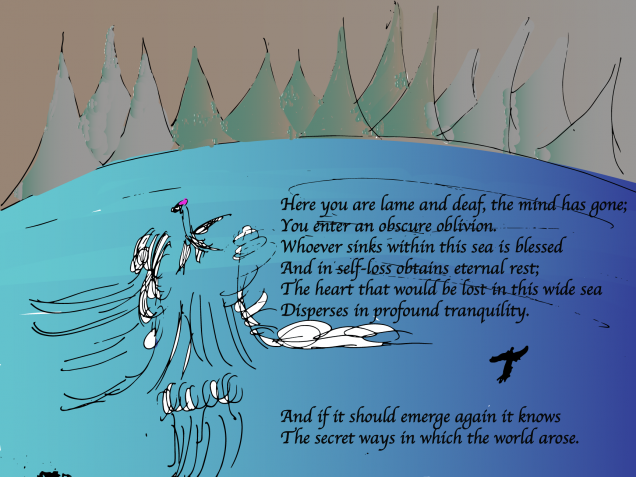 This scene depicts the Valley of Poverty & Nothingness, in which the pilgrim undergoes a Realization of God after being totally freed from its self. I made the image using Adobe Illustrator to digitize a hand-drawn sketch. Here we see the six valleys which have preceded this one in darker green. The ocean, deep and blue, reflects the enormity of nothingness. A dark silhouette of a bird has sunk and “in self-loss [has] obtain[ed] eternal rest”. Similarly, another bird, more vivid in color, has “emerged”, knowing “the secret ways in which the world arose”. The scene is deliberately devoid of a great many details to emphasise the emptiness of this place and its lack of distinctive features.
This scene depicts the Valley of Poverty & Nothingness, in which the pilgrim undergoes a Realization of God after being totally freed from its self. I made the image using Adobe Illustrator to digitize a hand-drawn sketch. Here we see the six valleys which have preceded this one in darker green. The ocean, deep and blue, reflects the enormity of nothingness. A dark silhouette of a bird has sunk and “in self-loss [has] obtain[ed] eternal rest”. Similarly, another bird, more vivid in color, has “emerged”, knowing “the secret ways in which the world arose”. The scene is deliberately devoid of a great many details to emphasise the emptiness of this place and its lack of distinctive features.
Background music: Original composition for Santur and Daf by Danial Shariat.
A note on the music: "It starts with an atempo noise of Santur and Daf before becoming a slow and solemn march. The lack of excitement or complexity and frequent use of silence creates a feeling of desolation, but also peace, in the listener." (DS)
Thirty Birds Arrive at the Court of the Simorgh
This scene depicts the final thirty birds arriving at the Court of the Simorgh as they slowly morph into the image of one larger, greater, unified bird. We drew this scene with colored pencils and a black pen and digitized it with Mac Preview. The white background signifies the emptiness of the Valley of Poverty & Nothingness from which they have just emerged. The colors, too, go from colder blues and greens in the back to warmer, fiery oranges and reds as "love [begins to make] the birds impetuous and unafraid." There are thirty birds, including some which still appear as circles, as "insubstantial, trembling atoms gaz[ing]" toward the "promised goal". This scene represents the final moment in which the birds are still distinct entities before their souls are enveloped into God and become One.
Background music: Original composition for Santur and Daf, with Tar accompaniment from freesound.org.
by Danial Shariat
The Birds Meet the Simorgh
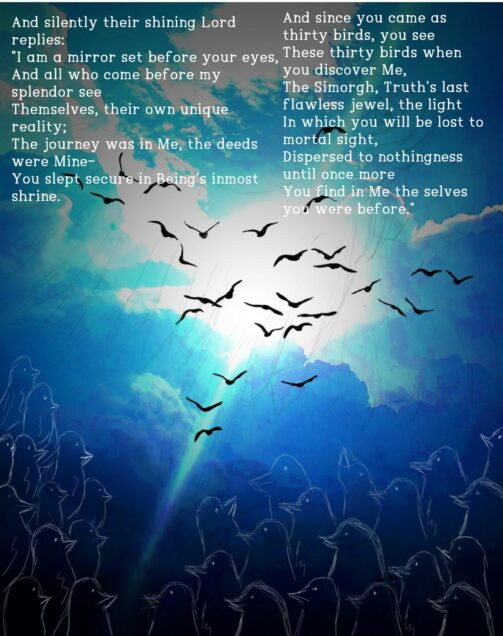
The following picture is a representation of the thirty birds who have completed the inner journey of reaching the Simorgh. There is a gathering of thirty birds at the bottom of the photograph, carefully observing a reflection of themselves above. The reflection is within the shining sun, representative of the Simorgh who reigns. The sunlight behind is a real photograph of the Sun taken at Cape Canaveral, FL, and the birds were drawn through an app called SketchBook. Behind the birds flying in the light of the sun sits a faint outline of the Simorgh, however it is not the prominent feature of the photograph, being representative of the fact that the birds and the Simorgh are now one. Also noteable is the importance of the light. Often, in Islamic movies or depictions of the religious history, both Allah (SWT) and even the Prophet Muhammad (SAW) are depicted as light sources, as they are forbidden to be depicted in any other visual way according to the Quran and a number of Hadiths (supplemental teachings). Incorporating our own light source in place of an actual visual representation of the Simorgh is our nod to the religion that inspired this work.
Background music: Original composition for Santur, with Tar accompaniment downloaded from freesound.org
by Danial Shariat
Their Souls Rise Free
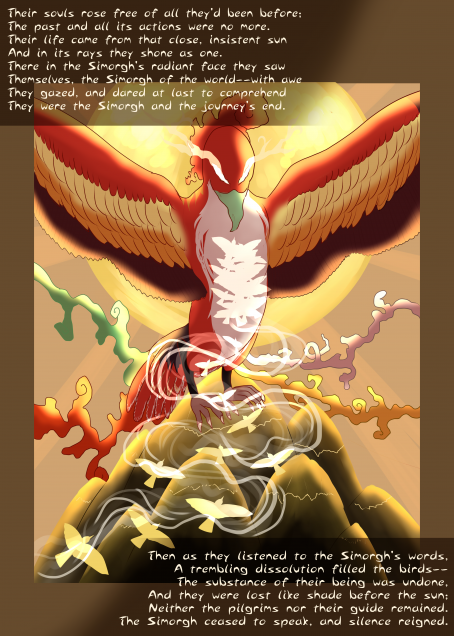
The Simorgh occupies the focal point of the illustration as the thirty birds rise to become one with Him. In order to convey that they are unified with Him, their figures become less and less distinguishable as they join with His form. To represent that the birds are no longer individuals, but rather united souls, they gradually become closer and closer to pure white. The Simorgh perches upon a mountaintop in order to signify His place overlooking and encompassing the entire world. His wings and the expanses of His tails span past the edges of the image in order to further represent this far-reaching influence. He is backlit by the sun, referencing the light imagery throughout our lines. The artwork relies on warm, bright colors to accent the majesty of Simorgh.
The concept was realized with paper and pencil, the image was inked in SketchUp 3D, and color and effects were completed in Clip Studio Paint.
Background music: Original composition for Daf and Ney
by Danial Shariat
